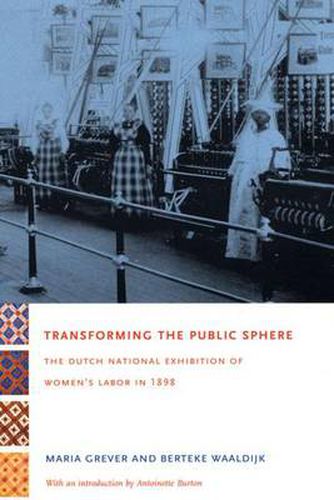Readings Newsletter
Become a Readings Member to make your shopping experience even easier.
Sign in or sign up for free!
You’re not far away from qualifying for FREE standard shipping within Australia
You’ve qualified for FREE standard shipping within Australia
The cart is loading…






In 1898, the year Queen Wilhelmina of the Netherlands was crowned, five hundred women organized an enormous public exhibition showcasing women’s contributions to Dutch society as workers in a strikingly broad array of professions. The National Exhibition of Women’s Labor, located in The Hague, was attended by more than ninety thousand visitors. Maria Grever and Berteke Waaldijk consider the exhibition in the international contexts of women’s history, visual culture, and imperialism. Transforming the Public Sphere provides a comprehensive social history based on extensive research. The authors describe the role of exhibitions in late-nineteenth-century public culture, the planning and construction of the 1898 women’s exhibition, and the event itself–the sights, sounds, and smells. They discuss how the exhibition displayed the range and variety of women’s economic, intellectual, and artistic roles in Dutch culture, including their participation in such traditionally male professions as engineering, diamond-cutting, and printing and publishing.They examine how people and goods from the Dutch colonies were represented, most notably in an extensive open-air replica of a Javanese village.
Grever and Waaldijk reveal the tensions the exhibition highlighted: between women of different economic classes, between the goal of equal rights for women and the display of imperial subjects and spoils, and between socialists and feminists, who competed fiercely with one another for working women’s support. Transforming the Public Sphere explores an event that served as the dress rehearsal for advances in women’s public participation during the twentieth century.
$9.00 standard shipping within Australia
FREE standard shipping within Australia for orders over $100.00
Express & International shipping calculated at checkout
In 1898, the year Queen Wilhelmina of the Netherlands was crowned, five hundred women organized an enormous public exhibition showcasing women’s contributions to Dutch society as workers in a strikingly broad array of professions. The National Exhibition of Women’s Labor, located in The Hague, was attended by more than ninety thousand visitors. Maria Grever and Berteke Waaldijk consider the exhibition in the international contexts of women’s history, visual culture, and imperialism. Transforming the Public Sphere provides a comprehensive social history based on extensive research. The authors describe the role of exhibitions in late-nineteenth-century public culture, the planning and construction of the 1898 women’s exhibition, and the event itself–the sights, sounds, and smells. They discuss how the exhibition displayed the range and variety of women’s economic, intellectual, and artistic roles in Dutch culture, including their participation in such traditionally male professions as engineering, diamond-cutting, and printing and publishing.They examine how people and goods from the Dutch colonies were represented, most notably in an extensive open-air replica of a Javanese village.
Grever and Waaldijk reveal the tensions the exhibition highlighted: between women of different economic classes, between the goal of equal rights for women and the display of imperial subjects and spoils, and between socialists and feminists, who competed fiercely with one another for working women’s support. Transforming the Public Sphere explores an event that served as the dress rehearsal for advances in women’s public participation during the twentieth century.